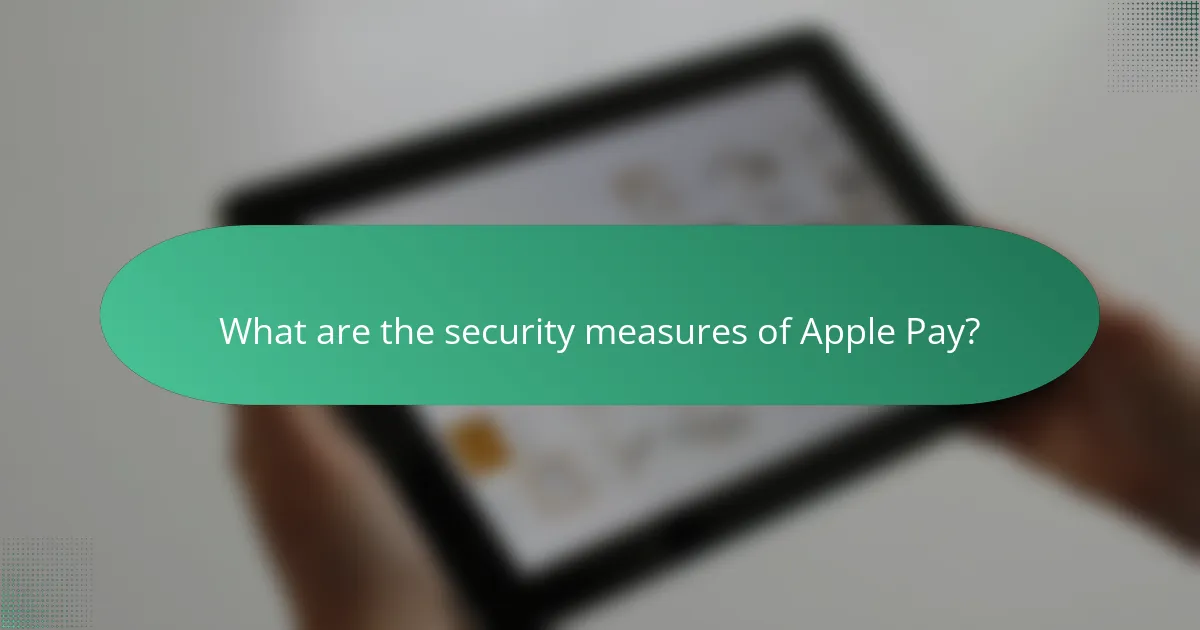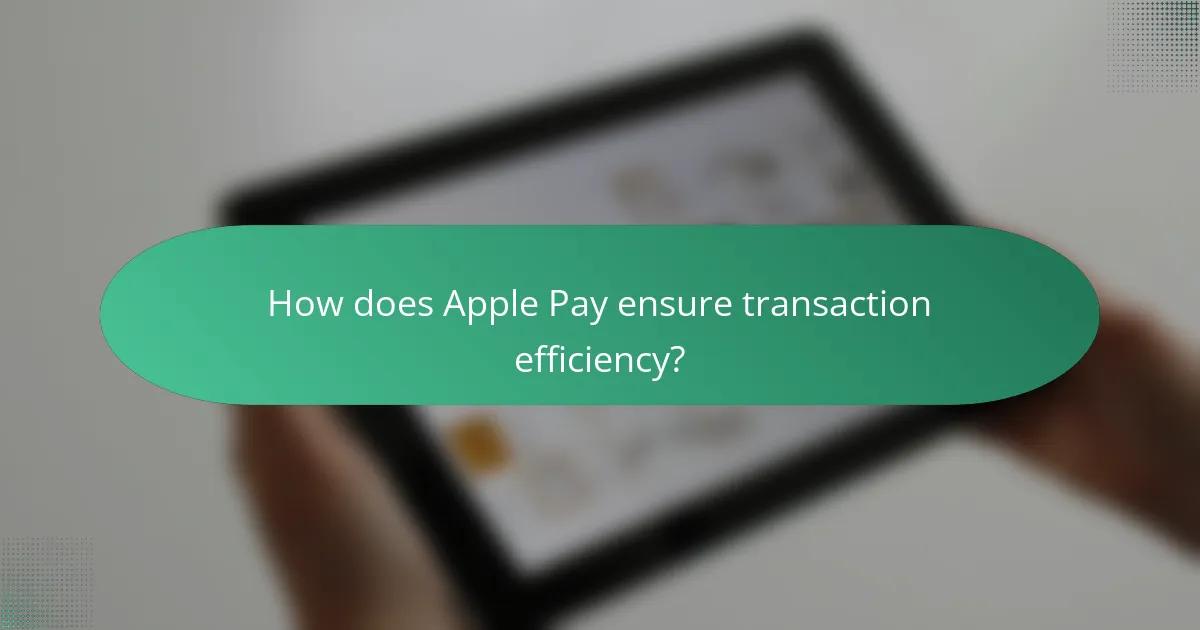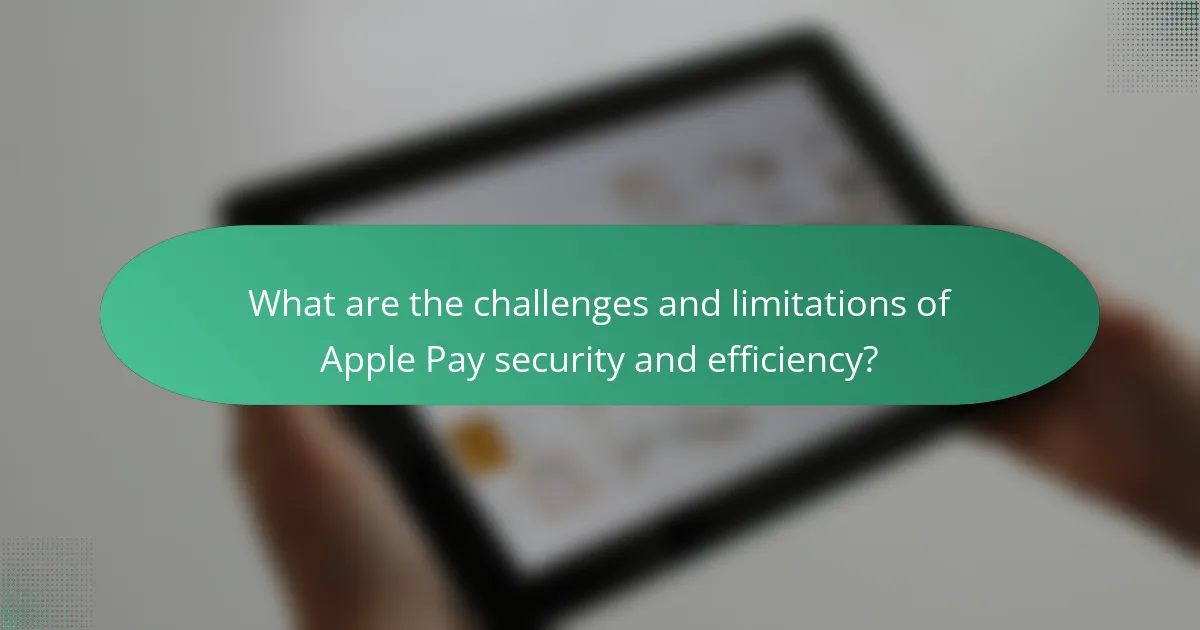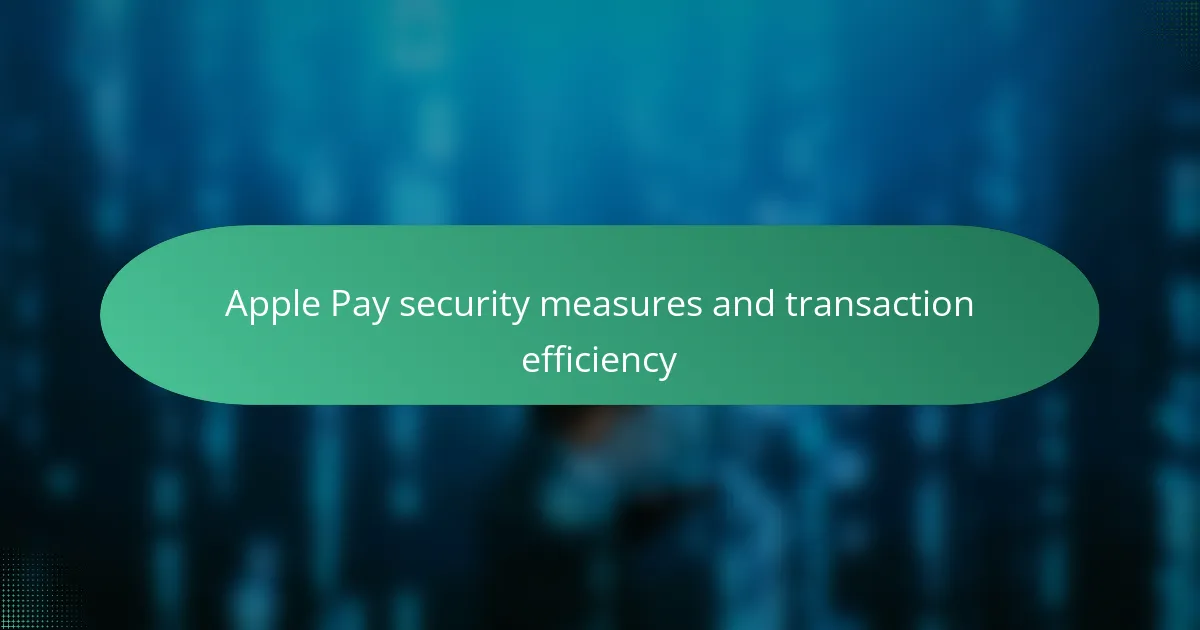Apple Pay is a digital payment solution that prioritizes user security and transaction efficiency. The article outlines the robust security measures employed by Apple Pay, including tokenization, biometric authentication, and encryption, all designed to protect user transactions and comply with PCI DSS standards. Additionally, it highlights the efficiency of Apple Pay through the use of Near Field Communication (NFC) technology, enabling quick and seamless transactions. However, the article also addresses challenges such as reliance on biometric systems, the need for an internet connection, potential data breaches, compatibility issues with older payment terminals, and varying merchant acceptance. Overall, the content provides a comprehensive overview of Apple Pay’s security framework and its operational effectiveness in the payment landscape.

What are the security measures of Apple Pay?
Apple Pay employs several robust security measures to protect user transactions. It uses tokenization to replace sensitive card information with a unique identifier. This unique token is generated for each transaction, ensuring that actual card details are not shared with merchants. Apple Pay also utilizes biometric authentication through Face ID or Touch ID, adding an additional layer of security.
Moreover, transactions require user authorization, preventing unauthorized access. Data is encrypted during transmission, safeguarding it from interception. Apple Pay’s security framework is designed to comply with PCI DSS standards, ensuring high security for payment processing. These measures collectively enhance the security of Apple Pay, making it a trusted payment solution.
How does Apple Pay protect user information?
Apple Pay protects user information through encryption and tokenization. When a user makes a payment, their card details are not shared with merchants. Instead, a unique transaction code is generated for each purchase. This code is encrypted and securely transmitted. Apple Pay also uses biometric authentication, such as Face ID or Touch ID, to authorize transactions. This adds an extra layer of security. Additionally, Apple does not store transaction history on its servers. This means that user data remains private and secure.
What encryption technologies are used in Apple Pay?
Apple Pay uses several encryption technologies to ensure transaction security. It employs end-to-end encryption for data transmission. This means that payment information is encrypted on the device and only decrypted by the payment processor.
Additionally, Apple Pay utilizes tokenization. This replaces sensitive card information with a unique token. The token is used for transactions, reducing the risk of fraud.
Apple also implements Secure Element technology. This is a dedicated chip within the device that securely stores payment information.
Furthermore, biometric authentication, such as Touch ID or Face ID, adds an extra layer of security. These methods ensure that only authorized users can initiate transactions.
Together, these technologies create a robust security framework for Apple Pay transactions.
How does tokenization enhance security in Apple Pay transactions?
Tokenization enhances security in Apple Pay transactions by replacing sensitive card information with unique identifiers called tokens. These tokens are generated for each transaction and do not contain actual card details. This means that even if a token is intercepted, it cannot be used for fraudulent activities.
Apple Pay employs a secure element within devices to store these tokens safely. The secure element is a dedicated chip that isolates sensitive data from the main operating system. This adds an additional layer of security against unauthorized access.
Furthermore, tokenization reduces the risk of data breaches. Since actual card numbers are not transmitted during transactions, merchants do not store sensitive information. This minimizes the potential for data theft.
In summary, tokenization in Apple Pay transactions significantly enhances security by using unique tokens, isolating data storage, and reducing the risk of data breaches.
What authentication methods are employed by Apple Pay?
Apple Pay employs several authentication methods to ensure secure transactions. The primary methods include biometric authentication, such as Touch ID and Face ID. Users can also authenticate transactions using a passcode. These methods enhance security by requiring user verification before processing payments. Apple Pay uses tokenization to protect card information during transactions. This means that actual card details are not shared with merchants. The combination of biometric data and tokenization contributes to a secure payment environment.
How does biometric authentication work in Apple Pay?
Biometric authentication in Apple Pay works by using either Touch ID or Face ID to verify a user’s identity. When a user initiates a payment, the device prompts for biometric verification. Touch ID uses a fingerprint scanner to capture the user’s fingerprint. Face ID employs advanced [censured] recognition technology to identify the user by analyzing [censured] features.
Once the biometric data is verified, the transaction proceeds securely. Apple Pay does not store the actual fingerprint or [censured] data on the device. Instead, it creates a unique mathematical representation of the biometric data. This representation is securely stored in the device’s Secure Enclave.
This process ensures that the user’s sensitive information remains protected during transactions. Apple Pay transactions are further secured with end-to-end encryption. This combination of biometric authentication and encryption provides a robust security framework for mobile payments.
What role does two-factor authentication play in Apple Pay security?
Two-factor authentication enhances Apple Pay security by adding an extra layer of protection. It requires users to verify their identity through a second method, typically a code sent to their device. This process helps prevent unauthorized access to accounts. Even if someone obtains a user’s password, they would still need the second factor to complete a transaction. Apple Pay employs this method to safeguard sensitive financial information. The implementation of two-factor authentication significantly reduces the risk of fraud. According to Apple, this security measure is crucial in protecting users’ payment data during transactions.

How does Apple Pay ensure transaction efficiency?
Apple Pay ensures transaction efficiency through its use of Near Field Communication (NFC) technology. NFC enables quick data transfer between devices, allowing transactions to be completed in seconds. The system employs tokenization, which replaces sensitive card information with a unique identifier. This process minimizes the risk of fraud and speeds up transaction processing. Apple Pay also integrates with existing payment infrastructure, enabling seamless transactions across various merchants. Additionally, the user interface is designed for simplicity, requiring minimal steps to complete a payment. These features collectively enhance the speed and reliability of transactions.
What factors contribute to the speed of Apple Pay transactions?
The speed of Apple Pay transactions is influenced by several key factors. First, the use of Near Field Communication (NFC) technology enables quick data transfer between devices. Second, Apple Pay leverages tokenization, which reduces the time needed for processing sensitive information. Third, the integration with biometric authentication, such as Face ID or Touch ID, allows for rapid user verification. Fourth, the established partnerships with financial institutions streamline transaction approvals. Additionally, the reliance on secure servers minimizes delays in processing requests. Each of these factors contributes to the overall efficiency and speed of Apple Pay transactions.
How does Near Field Communication (NFC) technology facilitate quick payments?
Near Field Communication (NFC) technology facilitates quick payments by enabling devices to communicate wirelessly over short distances. This technology allows users to make transactions by simply tapping their NFC-enabled device near a payment terminal. The communication occurs within a range of about four inches, ensuring swift and secure data exchange. NFC transactions are typically completed in seconds, which enhances the overall payment experience.
NFC uses secure elements to store payment information, reducing the risk of fraud. According to a study by the NFC Forum, NFC-enabled payments can be processed up to 10 times faster than traditional methods. This efficiency is crucial in fast-paced environments, such as retail settings. The combination of speed and security makes NFC a preferred choice for mobile payment solutions like Apple Pay.
What processes are involved in transaction authorization?
Transaction authorization involves several key processes. First, the user initiates a transaction using a payment method. This action sends transaction details to the payment processor. Next, the payment processor forwards the information to the card network. The card network then communicates with the bank that issued the card. The issuing bank evaluates the transaction for fraud and availability of funds. After assessment, the bank sends an approval or decline response back through the card network to the payment processor. Finally, the payment processor relays the result to the merchant. This sequence ensures secure and efficient transaction authorization.
How does Apple Pay integrate with merchants for seamless transactions?
Apple Pay integrates with merchants through NFC technology and a secure payment processing system. This allows customers to make transactions using their iPhones or Apple Watches at compatible terminals. Merchants must have NFC-enabled point-of-sale systems to accept Apple Pay. The integration involves tokenization, which replaces sensitive card information with a unique identifier for each transaction. This process enhances security by ensuring that actual card details are never shared with merchants. Additionally, Apple Pay supports various payment methods, including credit and debit cards. According to Apple, over 85% of U.S. retailers accept Apple Pay, demonstrating its widespread merchant integration.
What are the benefits of using Apple Pay for merchants?
Apple Pay offers several benefits for merchants. It enhances transaction efficiency by allowing quick and seamless payments. Merchants experience reduced transaction times, leading to improved customer satisfaction. Apple Pay also provides enhanced security features. These features include tokenization, which protects sensitive payment information. Additionally, Apple Pay transactions require biometric authentication, reducing the risk of fraud. According to a study by J.D. Power, 74% of consumers prefer mobile wallets for their convenience and security. This preference can lead to increased sales for merchants who adopt Apple Pay. Overall, using Apple Pay can streamline operations and attract more customers.
How does Apple Pay handle refunds and chargebacks efficiently?
Apple Pay handles refunds and chargebacks efficiently through a streamlined process integrated with participating merchants. Users initiate refunds directly within the app or through the merchant’s customer service. The system automatically processes these requests, ensuring that funds are returned to the user’s account promptly. Chargebacks are also facilitated through the app, where users can dispute transactions easily. This efficiency is supported by Apple’s secure transaction technology, which maintains transaction records for quick reference. According to Apple’s guidelines, merchants are encouraged to resolve issues swiftly to enhance customer satisfaction. This combination of user-friendly interfaces and robust merchant partnerships contributes to Apple Pay’s effective management of refunds and chargebacks.

What are the challenges and limitations of Apple Pay security and efficiency?
Apple Pay faces several challenges and limitations regarding security and efficiency. One challenge is the reliance on biometric authentication, which can be bypassed through spoofing techniques. Additionally, Apple Pay transactions require an active internet connection, which may hinder efficiency in areas with poor connectivity. Another limitation is the potential for data breaches, as user information is stored on devices. Moreover, users may face compatibility issues with older payment terminals that do not support contactless payments. Lastly, the lack of universal acceptance among merchants can restrict usability, impacting overall transaction efficiency.
What potential security vulnerabilities exist in Apple Pay?
Potential security vulnerabilities in Apple Pay include risks from device theft, phishing attacks, and transaction interception. If a user’s device is stolen, unauthorized individuals may attempt to access Apple Pay. This risk is mitigated by requiring biometric authentication or passcodes. Phishing attacks can trick users into providing their Apple ID or payment information. Users must stay vigilant against suspicious communications. Additionally, while Apple Pay transactions use encryption and tokenization, interception during transmission remains a theoretical risk. Security measures such as two-factor authentication help reduce these vulnerabilities. Overall, Apple Pay employs robust security protocols to protect users but is not entirely immune to risks.
How can users mitigate risks associated with Apple Pay?
Users can mitigate risks associated with Apple Pay by enabling two-factor authentication. This adds an extra layer of security by requiring a verification code in addition to the password. Users should also regularly update their devices to ensure they have the latest security patches. Keeping the Apple Pay app updated helps protect against vulnerabilities.
Users should monitor their transaction history frequently. This allows them to spot any unauthorized transactions quickly. If a user notices suspicious activity, they should report it to their bank immediately. Additionally, users should set up alerts for transactions made with Apple Pay. This provides real-time notifications of spending.
Using strong, unique passwords for their Apple ID is essential. This prevents unauthorized access to their accounts. Users should avoid sharing their Apple ID credentials. Sharing can lead to security breaches.
Finally, users should only add cards from trusted financial institutions. This reduces the risk of fraud. By following these strategies, users can enhance their security while using Apple Pay.
What are common issues users face regarding transaction efficiency?
Common issues users face regarding transaction efficiency include slow processing times and connectivity problems. Slow processing can occur due to network congestion or server delays. Connectivity issues may arise from weak internet signals or device compatibility. Users also report difficulties with app responsiveness during peak usage times. These factors can lead to frustration and hinder the overall transaction experience. Research indicates that 30% of users abandon transactions due to inefficiencies, highlighting the importance of addressing these issues for better user satisfaction.
How can users optimize their experience with Apple Pay?
Users can optimize their experience with Apple Pay by ensuring their devices are updated. Regular updates enhance security and improve functionality. Users should also enable Face ID or Touch ID for faster transactions. This biometric authentication increases both convenience and security. Adding multiple cards allows users to choose their preferred payment method quickly. Users can also organize their cards in the Wallet app for easier access. Utilizing Apple Pay at participating merchants ensures a seamless checkout experience. Lastly, users should review transaction notifications for monitoring and security purposes. These practices collectively enhance the overall efficiency and security of using Apple Pay.
What best practices should users follow to enhance their Apple Pay experience?
To enhance the Apple Pay experience, users should follow several best practices. First, keep the device updated to the latest iOS version. Apple frequently releases updates that improve security and functionality. Second, enable Face ID or Touch ID for quick and secure authentication. This adds an extra layer of security to transactions. Third, add all cards to Apple Wallet for easy access. Having multiple payment options can streamline the checkout process. Fourth, regularly review transaction history for any unauthorized charges. This helps in identifying potential fraud early. Fifth, use Apple Pay only at trusted merchants. This minimizes the risk of data breaches. Lastly, ensure that location services are enabled for better transaction accuracy. These practices collectively enhance security and efficiency when using Apple Pay.
Apple Pay is a mobile payment solution that incorporates various security measures and transaction efficiency strategies. The article details how Apple Pay utilizes tokenization, biometric authentication, and encryption technologies to protect user information and enhance transaction security. It also covers the efficiency of transactions through Near Field Communication (NFC) technology, the integration with merchants, and the factors that contribute to quick payment processing. Additionally, potential security vulnerabilities and best practices for users to mitigate risks and optimize their experience with Apple Pay are discussed.
